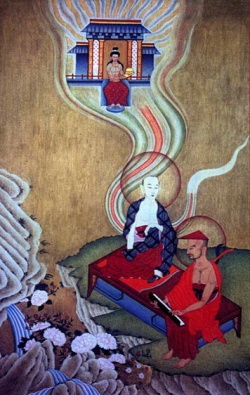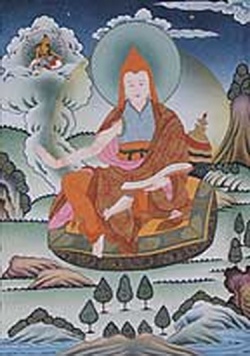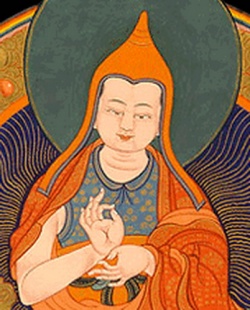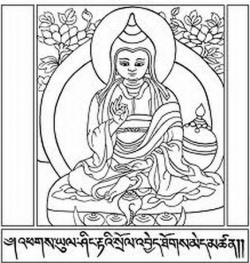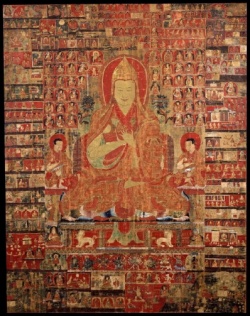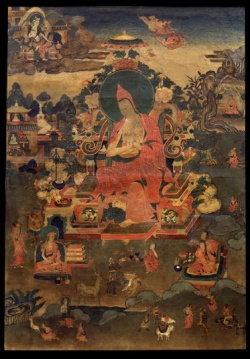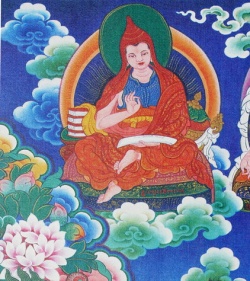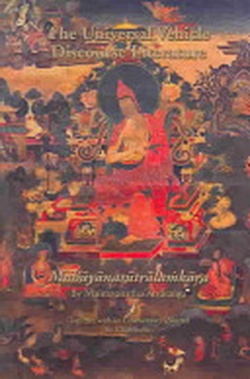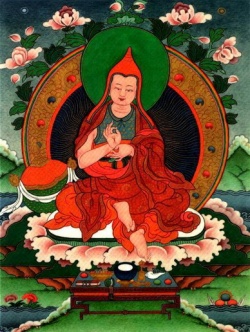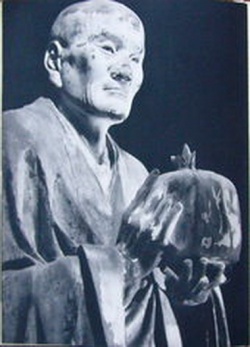Yogacara
Click here to see other articles relating to word Yogacara
- See also :
- See also :
Yogācāra (Sanskrit; literally: "yoga practice"; "one whose practice is yoga") is an influential school of Buddhist philosophy and psychology emphasizing phenomenology and (some argue) ontology through the interior lens of meditative and yogic practices. It developed within Indian Mahāyāna Buddhism in about the 4th century CE.
Yogācāra discourse explains how our human experience is constructed by mind.
Nomenclature, orthography and etymology
- Sanskrit: Yogācāra (योगाचार), Vijñānavāda (विज्ञानवाद), Vijñapti-mātra, Vijñapti-mātratā, or Cittamātra
- Chinese: Wéishí Zōng (唯識宗 "Consciousness-Only School"), Wéishí Yújiāxíng Pài (唯識瑜伽行派 "Consciousness-Only Yogācāra School"), Fǎxiàng Zōng (法相宗, "Dharmalakṣaṇa School"), Cí'ēn Zōng (慈恩宗 "Ci'en School")
- Japanese: Yuishiki (唯識 "Consciousness-Only"), Yugagyō (瑜伽行 "Yogācāra School")
- Korean: Yusig Jong (유식종 "Consciousness-Only School"), Yugahaeng Pa (유가행파 "Yogācāra School"), Yusig-Yugahaeng Pa (유식유가행파 "Consciousness-Only Yogācāra School")
- Vietnamese: Duy Thức Tông ("Consciousness-Only School"), Du-già Hành Tông ("Yogācāra School")
- Tibetan: sems-tsam
- Mongolian: егүзэр, yeguzer
- English: Yoga Practice School, Consciousness-Only School, Subjective Realism, Mind Only School
Yogācāra is also transliterated (using standard English alphabet) as "yogachara". Another name for the school is Vijñānavāda (Sanskrit). Vāda means "doctrine" and "way"; vijñāna means "consciousness" and "discernment."
History
The Yogācāra, along with the Mādhyamaka, is one of the two principal philosophical schools of Indian Mahāyāna Buddhism.
Origination
Masaaki (2005) states: "[a]ccording to the Saṃdhinirmocana Sūtra, the first Yogācāra text, the Buddha set the 'wheel of the doctrine' (Dharmacakra) in motion three times." Hence, the Saṃdhinirmocana Sūtra, as the doctrinal trailblazer of Yogācāra, inaugurated the paradigm of the three turnings of the wheel of Dharma, with its own tenets in the "third turning". The Yogācāra texts are generally considered part of the third turning along with the relevant sutra. Moreover, Yogācāra discourse surveys and synthesizes all three turnings.
The orientation of the Yogācāra school is largely consistent with the thinking of the Pāli Nikāyas. It frequently treats later developments in a way that realigns them with earlier versions of Buddhist doctrines. Dan Lusthaus concludes that one of the agendas of the Yogācāra school was to reorient the complexity of later refinements in Buddhist philosophy to accord with early Buddhist doctrine.
Asaṅga and Vasubandhu
Yogācāra, which had its genesis in the Saṃdhinirmocana Sūtra, was largely formulated by the brahmin born half-brothers Asaṅga and Vasubandhu. Asaṅga spent many years in intense meditation, during which time tradition says that he often visited Tuṣita Heaven to receive teachings from Maitreya Bodhisattva. Heavens such as Tuṣita Heaven are said to be accessible through meditation, and accounts of this are given in the writings of the Indian Buddhist monk Paramārtha, who lived during the 6th century CE. Xuanzang tells a similar account of these events:
- In the great mango grove five or six li to the southwest of the city (Ayodhyā), there is an old monastery where Asaṅga Bodhisattva received instructions and guided the common people. At night he went up to the place of Maitreya Bodhisattva in Tuṣita Heaven to learn the Yogācārabhūmi-śāstra, the Mahāyāna-sūtra-alaṃkāra-śāstra, the Madhyānta-vibhāga-śāstra, etc.; in the daytime, he lectured on the marvelous principles to a great audience.
Asaṅga went on to write many of the key Yogācāra treatises such as the Yogācārabhūmi-śāstra, the Mahāyāna-saṃgraha and the Abhidharma-samuccaya as well as other works, although there are discrepancies between the Chinese and Tibetan traditions concerning which works are attributed to him and which to Maitreya.
The Yogācāra school held a prominent position in Indian Buddhism for centuries after the time of Asaṅga and Vasubandhu. Teachings and derivations of this school have influenced and become well-established in East Asian Buddhism and Tibetan Buddhism.
Yogācāra and Mādhyamaka
As evidenced by Tibetan sources, this school was in protracted dialectic with the Mādhyamaka. However, there is disagreement among contemporary Western and traditional Buddhist scholars about the degree to which they were opposed, if at all. To summarize the main difference in a way so brief as to risk the accusation of inaccuracy, while the Mādhyamaka held that asserting the existence or non-existence of any ultimately real thing was inappropriate, some exponents of Yogācāra asserted that the mind (or in the more sophisticated variations, primordial wisdom) and only the mind is ultimately real. Not all Yogācārins, however, asserted that mind was truly existent. According to some interpretations, Vasubandhu and Asaṅga in particular did not.
The position that Yogācāra and Mādhyamaka were in dialectic, was expounded by Xuanzang in the 7th century. After a suite of debates with exponents of the Mādhyamaka school in India, Xuanzang composed in Sanskrit the no longer extant three-thousand verse treatise The Non-difference of Mādhyamaka and Yogācāra.
Some later Yogācāra exponents also synthesized the two views, particularly Śāntarakṣita [[]]in the 8th century, whose view was later called "Yogācāra-Svatantrika-Mādhyamaka" by the Tibetan tradition. In his view the Mādhyamika position is ultimately true and at the same time the mind-only view is a useful way to relate to conventionalities and progress students more skillfully toward the ultimate. This synthesized view between the two positions, which also incorporated views of valid cognition from Dignāga and Dharmakīrti, was one of the last developments of Indian Buddhism before it was extinguished in the 11th century during the Muslim incursion.
Yogācāra in East Asia
- See also :
- See also :
During the 6th century CE, the Indian monk and translator Paramārtha widely propagated Yogācāra teachings in China. His translations include the Saṃdhinirmocana Sūtra, the Madhyāntavibhāga-kārikā, the Triṃśikā-vijñaptimātratā, and the Mahāyānasaṃgraha. Paramārtha also taught widely on the principles of Consciousness Only, and developed a large following in southern China. Many monks and laypeople traveled long distances to hear his teachings, especially those on the Mahāyānasaṃgraha.
Although Yogācāra teachings had been propagated widely in China before the 7th century, most look to Xuanzang as the most important founder of East Asian Yogācāra. At the age of 33, Xuanzang made a dangerous journey to India in order to study Buddhism there and to procure Buddhist texts for translation into Chinese. Dan Lusthaus writes that Xuanzang had come to the conclusion that issues of dispute in Chinese Buddhism could be resolved with the availability of important texts, and especially the Yogācāra bhūmi Śāstra.
Xuanzang spent over ten years in India traveling and studying under various Buddhist masters. Lusthaus writes that during this time, Xuanzang discovered that the manner in which Buddhists understood and interpreted texts was much richer and more varied than the Chinese materials had previously indicated, and drew meaning from a broad cultural context. Xuanzang's teachers included Śīlabhadra, the abbot of Nālandā, who was then 106 years old. Xuanzang was tutored in the Yogācāra teachings by Śīlabhadra for several years at Nālandā. Upon his return from India, Xuanzang brought with him 657 Buddhist texts, including important Yogācāra works such as the Yogācārabhūmi Śāstra. Upon his return to China, he was given government support and many assistants for the purpose of translating these texts into Chinese.
As an important contribution to East Asian Yogācāra, Xuanzang composed the treatise Cheng Weishi Lun, or "[[Discourse}} on the Establishment of Consciousness Only]]." This work is framed around Vasubandhu's Triṃśikā-vijñaptimātratā, or "Thirty Verses on Consciousness Only." Xuanzang upheld Dharmapāla's commentary on this work as being the correct one, and provided his own explanations of these as well as other views in the Cheng Weishi Lun. This work was composed at the behest of Xuanzang's disciple Kuiji, and became a central representation of East Asian Yogācāra. Xuanzang also promoted devotional meditative practices toward Maitreya Bodhisattva. Xuanzang's disciple Kuiji wrote a number of important commentaries on the Yogacara texts and further developed the influence of this doctrine in China, and was recognized by later adherents as the first true patriach of the school.
Yogācāra in Tibet
Yogācāra was transmitted to Tibet by Śāntarakṣita and later by Atiśa; it was thereafter integral to Tibetan Buddhism although the prevailing Geluk-dominated view held that it was less definitive than Mādhyamaka. Yogācāra terminology (but not view) is used by the Nyingmapa and its zenith, Dzogchen.
Current debates among Tibetan schools between the shentong (empty of other) and rangtong (empty of self) views appear similar to earlier debates between Yogācāra and Mādhyamaka, but the issues and distinctions have evolved further. Though the later Tibetan views could be said to have evolved from the earlier Indian positions, the distinctions between the views became increasingly subtle, especially after Yogācāra incorporated the Mādhyamika view of the ultimate. Ju Mipham, the 19th century rime movement commenter, wrote in his commentary on Śāntarakṣita's synthesis, that the ultimate view in both schools is the same and each path also leads to the same ultimate state of abiding.
Principal exponents of Yogācāra
Principal exponents of Yogācāra categorized and alphabetized according to location:
- China: Paramārtha 真諦(499 – 569), Xuanzang 玄奘(602 – 664) and Kuiji 窺基 (K'uei-chi; 632 – 682);
- India: the half-brothers Asaṅga and Vasubandhu; Sthiramati 安慧 and Dharmapāla 護法
- Japan: Chitsū 智通 and Chidatsu 智達 (NB: both these people are mentioned in Kusha (Buddhism))
- Korea: Daehyeon 大賢, Sinhaeng (神行 ;704-779), Wonch'uk (圓測 ; 631-696) and Wonhyo (zh: 元曉 ; 원효; 617 - 686)
- Tibet: Dolpopa, Tāranātha, Jamgon Kongtrul Lodro Thaye, Ju Mipham
Textual corpus
Sutras
The Sandhinirmocana Sutra, Unravelling the Mystery of Thought Sutra (2nd century CE), was the seminal Yogācāra sutra and continued to be a primary referent for the tradition.
Also containing Yogācāra elements were the Pratyutpanna Samādhi Sūtra (1st century CE) and Daśabhūmika Sūtra (pre-3rd century CE).
The later Descent into Laṅkā Sūtra (Laṅkāvatāra Sūtra, 4th century CE) also assumed considerable importance.
Other prominent Yogācāra sutras include the Śrīmālādevīsiṃhanāda Sūtra and the Ghanavyūha Sūtra.
Five treatises of Maitreya
Among the most important texts to the Yogācāra tradition is the Five Treatises of Maitreya. These texts are said to have been related to Asaṅga by the Bodhisattva Maitreya, though Maitreya may have been the actual founder of the Yogacra-school. They are as follows:
- Ornament for Clear Realization (Abhisamaya-alaṅkāra, Tib. mngon-par rtogs-pa'i rgyan)
- Ornament for the Mahāyāna Sutras (Mahāyāna-sūtra-alaṅkāra, Tib. theg-pa chen-po'i mdo-sde'i rgyan)
- Sublime Continuum of the Mahāyāna (Ratna-gotra-vibhāga, Tib. theg-pa chen-po rgyud bla-ma'i bstan)
- Distinguishing Phenomena and Pure Being (Dharma-dharmatā-vibhāga, Tib. chos-dang chos-nyid rnam-par 'byed-pa)
- Distinguishing the Middle and the Extremes (Madhyānta-vibhāga, Tib. dbus-dang mtha' rnam-par 'byed-pa)
A commentary on the Ornament for Clear Realization called "Clarifying the Meaning" by Haribhadra is also often used, as is one by Vimuktisena.
Most of these texts were also incorporated into the Chinese tradition, which was established several centuries earlier than the Tibetan. However, the Ornament for Clear Realization is not mentioned by Chinese translators up to the 7th century, including Xuanzang, who was an expert in this field. This suggests it may possibly have emerged from a later period than is generally ascribed to it.
Asanga
Authorship of critical Yogācāra texts is also ascribed to Asaṅga personally (in contrast to the Five Treatises of Maitreya). Among them are the Mahāyāna-saṃgraha and the Abhidharma-samuccaya. Sometimes also ascribed to him is the Yogācāra bhūmi Śāstra, a massive encyclopedic work considered the definitive statement of Yogācāra, but most scholars believe it was compiled a century later, in the 5th century, while its components reflect various stages in the development of Yogācāra thought.
Vasubandhu
Vasubandhu is considered to be the systematizer of Yogacara-thought.
Vasubandhu wrote three foundational texts of the Yogācāra:
- Trisvabhāva-nirdeśa (Treatise on the Three Natures, Tib. Rang-bzhin gsum nges-par bstan)
- Viṃśaṭikā-kārikā (Treatise in Twenty Stanzas)
- Triṃśikaikā-kārikā (Treatise in Thirty Stanzas)
He also wrote an important commentary on the Madhyantavibhaṅga. According to Buddhist scholar Jay Garfield:
- While the Trisvabhāva-nirdeśa is arguably the most philosophically detailed and comprehensive of the three short works on this topic composed by Vasubandu, as well as the clearest, it is almost never read or taught in contemporary traditional cultures or centers of learning. The reason may be simply that this is the only one of Vasubandhu’s root texts for which no autocommmentary exists. For this reason, none of Vasubandhu’s students composed commentaries on the text and hence there is no recognized lineage of transmission for the text. So nobody within the Tibetan tradition (the only extant Mahāyāna scholarly tradition) could consider him or herself authorized to teach the text. It is therefore simply not studied, a great pity. It is a beautiful and deep philosophical essay and an unparalleled introduction to the Cittamatra system. ]
Later commentaries
Other important commentaries on various Yogācāra texts were written by Sthiramati (6th century) and Dharmapāla (7th century), and an influential Yogācāra-Mādhyamaka synthesis was formulated by Śāntarakṣita (8th century). Tenets
Yogacara is "meant to be an explanation of experience, rather than a system of ontology". It uses various concepts in providing this explanation: representation-only, the eight consciousnesses, the three natures, emptiness. They form a complex system, each of which can be taken as a point of departure for understanding Yogacara:
- In the vast and complex system that is known as Yogācāra, all of these different approaches and categories are ultimately tied into each other, and thus, starting with any one of them, one can eventually enter into all of the rest."
Yogacara is usually treated as a philosophical system, but it is a school of practice as well:
- Yogācāra attaches importance to the religious practice of yoga as a means for attaining final emancipation from the bondage of the phenomenal world. The stages of yoga are systematically set forth in the treatises associated with this tradition.
Yogācārins developed an Abhidharma literature set within a Mahāyāna framework.
Representation-only
One of the main features of Yogācāra philosophy is the concept of vijñapti-mātra. It is often used interchangeably with the term citta-mātra, but they have different meanings. The standard translation of both terms is "consciousness-only" or "mind-only." Several modern researchers object this translation, and the accompanying label of "absolute idealism" or "idealistic monism". A better translation for vijñapti-mātra is representation-only.
According to Kochumuttom, Yogacara is an realistic pluralism. It does not deny the existence of individual beings :
- What it denies are:
- That the absolute mode of reality is consciousness/mind/ideas,
- That the individual beings are transformations or evolutes of an absolute consciousness/mind/idea,
- That the individual beings are but illusory appearances of a monistic reality.
Vijñapti-mātra then means "mere representation of consciousness:
- [T]he phrase vijñaptimātratā-vāda means a theory which says that the world as it appears to the unenlightened ones is mere representation of consciousness. Therefore, any attempt to interpret vijñaptimātratā-vāda as idealism would be a gross misunderstanding of it.
The term vijñapti-mātra replaced the "more metaphysical" term citta-mātra used in the Lankavatara Sutra. The Lankavatara Sutra "appears to be one of the earliest attempts to provide a philosophical justification for the Absolutism that emerged in Mahayana in relation to the concept of Buddha". It uses the term citta-mātra, which means properly "thought-only". By using this term it develops an ontology, in contrast to the epistemology of the term vijñapti-mātra. The Lankavatara Sutra equates citta and the absolute. According to Kochumuttom, this not the way Yogacara uses the term vijñapti:
- [T]he absolute state is defined simply as emptiness, namely the emptiness of subject-object distinction. Once thus defined as emptiness (sunyata), it receives a number of synonyms, none of which betray idealism.
The term citta-mātra was used in Tibet and East Asia interchangeably with "Yogācāra", although modern scholars believe it is inaccurate to conflate the two terms.
Consciousness
Yogacara gives a detailed explanation of the workings of the mind and the way it constructs the reality we experience. Vasubandhu used the concept of the six consciousnesses, on which he elaborated in the Triṃśikaikā-kārikā (Treatise in Thirty Stanzas).
According to the traditional interpretation, Vasubandhu states that there are eight consciousnesses: the five sense-consciousnesses, mind (perception), manas (self-consciousness)[42], and the storehouse-consciousness. According to Kalupahana, this classification of eight consciousnesses is based on a misunderstanding of Vasubandhu's Triṃśikaikā-kārikā by later adherents. [a]
Karma, seeds and storehouse-consciousness
According to the traditional explanation, the theory of the consciousnesses attempted to explain all the phenomena of cyclic existence, including how rebirth occurs and precisely how karma functions on an individual basis. It addressed questions that had long vexed Buddhist philosophers, such as,
- 'If one carries out a good or evil act, why and how is it that the effects of that act do not appear immediately?'
- 'Insofar as they do not appear immediately, where is this karma waiting for its opportunity to play out?'
The answer given by later Yogācārins was the store consciousness (Sanskrit: ālayavijñāna), also known as the basal, or eighth consciousness. It simultaneously acts as a storage place for karmic latencies and as a fertile matrix of predispositions that bring karma to a state of fruition.
The likeness of this process to the cultivation of plants led to the creation of the metaphor of seeds (Sanskrit: bīja) to explain the way karma is stored in the eighth consciousness. In the Yogācāra formulation, all experience without exception is said to result from the ripening of karma. The seemingly external world is merely a "by-product" (adhipati-phala) of karma. The term vāsanā ("perfuming") is also used, and Yogācārins debated whether vāsāna and bija were essentially the same, the seeds were the effect of the perfuming, or whether the perfuming simply affected the seeds. The type, quantity, quality and strength of the seeds determine where and how a sentient being will be reborn: one's race, gender, social status, proclivities, bodily appearance and so forth. The conditioning of the mind resulting from karma is called saṃskāra.
The Treatise on Action (Karmasiddhiprakaraṇa), also by Vasubandhu, treats the subject of karma in detail from the Yogācāra perspective.
Transformations of consciousness
The traditional interpretation may be discarded on the ground of a reinterpretation of Vasubandhu's works.
According to scholar Roger R. Jackson, a "'fundamental unconstructed awareness' (mūla-nirvikalpa-jñāna)" is "described [...] frequently in Yogacara literature.", Vasubandhu's work
According to Kalupahana, instead of positing additional consciousnesses, the Triṃśikaikā-kārikā describes the transformations of this consciousness:
- Taking vipaka, manana and vijnapti as three different kinds of functions, rather than characteristics, and understanding vijnana itself as a function (vijnanatiti vijnanam), Vasubandhu seems to be avoiding any form of substantialist thinking in relation to consciousness.
These transformations are threefold:
- Whatever, indeed, is the variety of ideas of self and elements that prevails, it occurs in the transformation of consciousness. Such transformation is threefold,
The first transformation results in the alaya: [[File:Asanga_Vasubandhu_cvt_.jpeg|thumb|250px|]]
- the resultant, what is called mentation, as well as the concept of the object. Herein, the consciousness called alaya, with all its seeds, is the resultant.
The alaya-vijnana therefore is not an eight consciousness, but the resultant of the transformation of consciousness:
- Instead of being a completely distinct category, alaya-vijnana merely represents the normal flow of the stream of consciousness uninterrupted by the appearance of reflective self-awareness. It is no more than the unbroken stream of consciousness called the life-process by the Buddha. It is the cognitive process, containing both emotive and conative aspects of human experience, but without the enlarged egoistic ermotions and dogmatic graspings characteristic of the next two transformations.
The second transformation is manana, self-consciousness or "Self-view, self-confusion, self-esteem and self-love". According to the Lankavatara and later interpreters it is the seventh consciousness. It is "thinking" about the various perceptions occurring in the stream of consciousness". The alaya is defiled by this self-interest;
- [I]t can be purified by adopting a non-substantialist (anatman) perspective and thereby allowing the alaya-part (i.e. attachment) to dissipate, leaving consciousness or the function of being intact.
The third transformation is visaya-vijnapti, the "concept of the object". In this transformation the concept of objects is created. By creating these concepts human beings become "susceptible to grasping after the object":
- Vasubandhu is critical of the third transformation, not because it relates to the conception of an object, but because it generates grasping after a "real object" (sad artha), even when it is no more than a conception (vijnapti) that combines experience and reflection.
A similar perspective is give by Walpola Rahula. According to Walpola Rahula, all the elements of the Yogācāra storehouse-consciousness are already found in the Pāli Canon. He writes that the three layers of the mind (citta, manas, and vijñana) as presented by Asaṅga are also mentioned in the Pāli Canon:
- Thus we can see that 'Vijñāna' represents the simple reaction or response of the sense organs when they come in contact with external objects. This is the uppermost or superficial aspect or layer of the 'Vijñāna-skandha'. 'Manas' represents the aspect of its mental functioning, thinking, reasoning, conceiving ideas, etc. 'Citta' which is here called 'Ālayavijñāna', represents the deepest, finest and subtlest aspect or layer of the Aggregate of consciousness. It contains all the traces or impressions of the past actions and all good and bad future possibilities.
Tathagata-garba thought
The store consciousness concept developed along with the Buddha nature doctrine and resolved into the concept of mind-stream or the "consciousness-continuity" (Sanskrit: citta-santāna) to avoid being denounced as running counter to the doctrine of emptiness (śūnyatā) and the tenets of selflessness (anātman).
It may be ultimately traceable to the "luminous mind" mentioned once in the Āgamas, but according to Kalupahana,
- The concept of alaya is borrowed from Lankavatara; but it does not have the same characteristics nor does it function in the same way. It is neither "the originally pure mind" (prakrti-prabhasvara-citta) nor "the location of the womb (of enlightenment)" (garbha-samsthana).
The Three Natures
The Yogācārins defined three basic modes by which we perceive our world. These are referred to in Yogācāra as the three natures of perception. They are:
- Parikalpita (literally, "fully conceptualized"): "imaginary nature", wherein things are incorrectly comprehended based on conceptual construction, through attachment and erroneous discrimination.
- Paratantra (literally, "other dependent"): "dependent nature", by which the correct understanding of the dependently originated nature of things is understood.
- Pariniṣpanna (literally, "fully accomplished"): "absolute nature", through which one comprehends things as they are in themselves, uninfluenced by any conceptualization at all.
Also, regarding perception, the Yogācārins emphasized that our everyday understanding of the existence of external objects is problematic, since in order to perceive any object (and thus, for all practical purposes, for the object to "exist"), there must be a sensory organ as well as a correlative type of consciousness to allow the process of cognition to occur.
Emptiness in Yogācāra
The doctrine of śūnyatā is central to Yogācāra, as to any Mahāyāna school. Early Yogācāra texts, such as the Saṃdhinirmocana Sūtra and the Yogācāra bhūmi Śāstra, often act as explanations of the Prajñāpāramitā sūtras. Related concepts as dependent arising (pratītyasamutpāda) and the doctrine of two truths are also central in Yogācāra thought and meditation.
But the Yogacara-school developed its own insights on the nature of sunyata:
- [T]he Yogācāra thinkers did not simply comment on Mādhyamika thought. They attempted to ground insight into emptiness in a critical understanding of the mind, articulated in a sophisticated theoretical discourse.
Yogacara has a positive approach of emptiness:
- Although meaning 'absence of inherent existence' in Mādhyamaka, to the Yogācārins emptiness means 'absence of duality between perceiving subject (grāhaka, 'dzin-pa) and the perceived object (grāhya, bzhung-ba).'"
Each of the three natures has its corresponding "absence of nature":
- parikalpita => lakṣana-niḥsvabhāvatā, the "absence of inherent characteristic"
- paratantra => utpatti-niḥsvabhāvatā, the "absence of inherent arising"
- pariniṣpanna => paramārtha-niḥsvabhāvatā, the "absence of inherent ultimacy"
Each of these "absences" is a form of emptiness, i.e. the nature is "empty" of the particular qualified quality.
Yogācāra gave special significance to the Lesser Discourse on Emptiness of the Āgamas. It is often quoted in later Yogācāra texts as a true definition of emptiness.
Meditation and awakening
As the name of the school suggests, meditation practice is central to the Yogācāra tradition. Practice manuals prescribe the practice of mindfulness of body, feelings, thoughts and dharmas in oneself and others, out of which an understanding of the non-differentiation of self and other is said to arise. This process is referred to in the Yogācāra tradition as āśraya-parāvṛtti, "turning about in the basis", or "revolution of the basis" , the basis being the storehouse consciousness:
- ... a sudden revulsion, turning, or re-turning of the ālaya vijñaña back into its original state of purity [...] the Mind returns to its original condition of non-attachment, non-discrimination and non-duality".
In this awakening it is realized that obeserver and observed are not distinct entities, but mutual co-dependent.
Contemporary scholarship
Accordiny to Lusthaus, Étienne Lamotte, a famous student of Louis de La Vallée-Poussin, "...profoundly advanced Yogācāra studies, and his efforts remain unrivaled among Western scholars."
Philosophical dialogue: Yogācāra, idealism and phenomenology
Yogācāra has also been identified in the western philosophical tradition as idealism, or more specifically subjective idealism. This equation was standard until recently, when it began to be challenged by scholars such as Kochumuttom, Anacker, Kalupahana , Dunne, Lusthaus, Powers, and Wayman. [c] Buddhist scholar Jay Garfield continues to uphold the equation of Yogācāra and idealism, however. To the same effect, Nobuyoshi Yamabe states that "Dignāga also clearly inherited the idealistic system of Yogācāra." Like many contemporary scholars, Yamabe is aware that the texts considered to be Yogācāra treatises reflect various stages in addressing the issue of mind and matter. Yogācāra has also been aligned with phenomenalism. In modern western philosophical discourse, Edmund Husserl and Maurice Merleau-Ponty have approached what western scholarship generally concedes to be a standard Yogācāra position.
Legacy
There are two important aspects of the Yogācāra schemata that are of special interest to modern-day practitioners. One is that virtually all schools of Mahāyāna Buddhism came to rely on these Yogācāra explanations as they created their own doctrinal systems, including the Zen schools. For example, the early Zen tradition in China was sometimes referred to simply as the "Laṅkāvatāra school" (Ch. 楞伽宗, Léngqié Zōng, due to their strong association with the Laṅkāvatāra Sūtra. This sūtra draws heavily upon Yogācāra theories of the eight consciousnesses, especially the ālayavijñāna. Accounts recording the history of this early period are preserved in Records of the Laṅkāvatāra Masters (Ch. 楞伽師資記, Léngqié Shīzī Jì).
That the scriptural tradition of Yogācāra is not yet well-known among the community of western practitioners is perhaps attributable to the fact that most of the initial transmission of Buddhism to the west has been directly concerned with meditation and basic doctrines. However, within Tibetan Buddhism more and more western students are becoming acquainted with this school. Very little research in English has been carried out on the Chinese Yogācāra traditions.
Source
Yogachara (Skt. Yogācāra; Tib. རྣལ་འབྱོར་སྤྱོད་པ་, Wyl. rnal 'byor spyod pa) or 'School of Yoga Practitioners' — another name given to the Chittamatra school of Mahayana Buddhism, founded by Asanga, because of its emphasis on practice.
